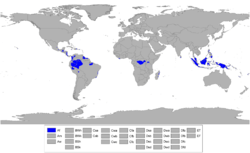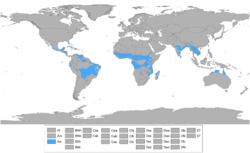Tropical climate
Tropical climate (otherwise known as “megathermal climate”) is one of the five major climate groups in the Köppen climate classification. Tropical climates are characterized by monthly average temperatures of 18℃ (64.4 ℉) or higher year-round, and have high levels of precipitation. There are no remarkable seasonal variations in tropical climates. Most tropical climate regions are located around the Equator with latitudes ranging from 25 degrees south to 24 degrees north.

There are three types of climates belonging to the Tropical Climate group: Tropical rainforest climate(Af), Tropical monsoon climate(Am) and Tropical wet and dry or savanna climate(Aw or As), which are classified and distinguished by the annual precipitation and the precipitation level of the driest month in those regions.
Köppen climate classification
Köppen climate classification is one of the most widely used climate classification systems. It defines a tropical climate as a region where the temperature of the coldest month is greater than or equal to 18℃ (64.4 ℉) and classifies them as an A-group (tropical climate group).[1] A-group regions are usually found around the Equator, including Central America, northern part of South America, central part of Africa, southern part of Asia and the Pacific Ocean islands.[2]
In Group A, there are three types of climate: Tropical rainforest climate(Af), Tropical monsoon climate(Am) and Tropical wet and dry or savanna climate (Aw or As). All of the three climates are classified by their Pdry (short for precipitation of the driest month).Tropical rainforest climate’s Pdry should be greater or equal than 60mm (2.4 inches). Tropical monsoon climate’s Pdry should be in the range from to 60mm. Tropical wet and dry or savanna climate’s Pdry should be less than .[1]



Tropical climate biome
The tropics have the characteristics of small temperature changes and long summers. Due to the high temperature and abundant rainfall, some plants can grow throughout the year. High temperature and humidity is the most suitable environment for epiphytes to grow. Plants of all sizes can vegetate under tropical climates. Vegetations grow in layers: shrubs under tall trees, and bushes under shrubs. Almost every inch of space is being well used. Tropical plants are rich in resources, including coffee, cocoa and oil palm. [3][4] Listed below are types of vegetation unique to each of the three climates that make up the tropical climate biome.
Natural vegetation
Tropical Rainforest vegetation including: Bengal bamboo, Bougainvillea, Curare, Coconut tree, Durian
Tropical Monsoon vegetation including: Teak, Deodar, Rosewood, Sandalwood, Bamboo
Tropical wet and dry or savanna vegetation including: Acacia senegal, Elephant grass, Jarrah tree, Gum tree eucalyptus, Whistling thorn
Tropical rainforest climate
The Köppen classification identifies tropical rainforest climate (Zone Af: f = feuch, German for moist) as having north and south latitudinal ranges of 5-10 degrees from the equator. [5] [6] Tropical rainforest climates have high temperatures: the yearly average temperature is between 70°F to 85°F (21°C to 30°C).[7][8] The precipitation can reach over 100 inches a year. [7] [8]The seasons are evenly distributed throughout the year, and there is almost no drought period. [6]Regions affected by tropical rainforest climate mainly include the upper Amazon basin of South America, the Northern Zaire (Congo) basin of Africa, and the islands of the East Indies. [6]
The tropical rainforest climate differs from other subtypes of tropical climates as it has more kinds of trees [8]. The large number of trees contribute to the humidity of the climate because of the transpiration, which is the process of water lost from the surface of living plants to the atmosphere. The warmth and abundant precipitation contributes to the diversity and characteristics of vegetations under the tropical rainforest climate. [7]The vegetations develop a vertical stratification and various growth forms to receive enough sunlight, which is unusual under other types of climate. [7]
Tropical monsoon climate
| Miami | ||||||||||||||||||||||||||||||||||||||||||||||||||||||||||||
|---|---|---|---|---|---|---|---|---|---|---|---|---|---|---|---|---|---|---|---|---|---|---|---|---|---|---|---|---|---|---|---|---|---|---|---|---|---|---|---|---|---|---|---|---|---|---|---|---|---|---|---|---|---|---|---|---|---|---|---|---|
| Climate chart (explanation) | ||||||||||||||||||||||||||||||||||||||||||||||||||||||||||||
| ||||||||||||||||||||||||||||||||||||||||||||||||||||||||||||
| ||||||||||||||||||||||||||||||||||||||||||||||||||||||||||||
The Köppen classification tool identifies tropical monsoon climate as having small annual temperature ranges, high temperatures, and plentiful precipitation. This climate also has a short dry season which occurs in the winter.[9] The tropical monsoon climate is usually found within countries in the south and southeast Asia region between the latitude of 10 degrees north and the Tropic of Cancer. These regions include India, Philippines, the northern coast of Australia and Hainan Island of China. The annual temperature of regions under tropical monsoon climate is stable.
The tropical monsoon climate has the following main characteristic. The average annual temperature is 27.05°C (80.7°F) and has an annual temperature range of 3.6°C (2°F). [10] Distinction between wet and drought seasons, the tropical monsoon climate is different from other tropical climates because of its uneven precipitation throughout the year. The precipitation is heavy in the summer, and a short-drought season occurs in the winter. This climate has an annual total precipitation of 3409.2mm, and a 3115.9mm summer precipitation and 293.3mm winter precipitation.[10]
There are three main seasons of tropical monsoon climate: the cool dry season is from October to February, the hot dry season is from March to mid-June and the rainy season is from mid-June to September. [11]
The tropical monsoon forest mainly consists of three layered structures. The first layer is the ground layer which is a very dense layer of shrubs. The second layer is the understory layer with trees about 15 meters tall. The top layer is called the canopy tree which has trees from 25 to 30 meters tall and those trees grow closely.
Tropical wet and dry or savanna climate
| Brasília, Brazil | ||||||||||||||||||||||||||||||||||||||||||||||||||||||||||||
|---|---|---|---|---|---|---|---|---|---|---|---|---|---|---|---|---|---|---|---|---|---|---|---|---|---|---|---|---|---|---|---|---|---|---|---|---|---|---|---|---|---|---|---|---|---|---|---|---|---|---|---|---|---|---|---|---|---|---|---|---|
| Climate chart (explanation) | ||||||||||||||||||||||||||||||||||||||||||||||||||||||||||||
| ||||||||||||||||||||||||||||||||||||||||||||||||||||||||||||
| ||||||||||||||||||||||||||||||||||||||||||||||||||||||||||||
The regions under this climate are mainly located near the equator between 10° north-south latitude and north and south of the tropic of cancer. Typical regions include central Africa, most of South America and Brazil, as well as northern and eastern Australia. [12] The temperature range of savanna climate is between 20°C to 30°C (68°F - 86°F). In summer, the temperature is between 25°C - 30°C, while in winter the temperature is between 20°C - 30°C. [13] The annual precipitation is between 700 to 1000 mm. The driest months are from November to March and they have less than 60 mm of rainfall.
Regions under the savanna climate usually have lands covered with flat grassland vegetation. Those grassland biomes cover almost 20% of the earth’s surface.[14]The grassland vegetation types include Rhodes grass, red oats grass, star grass and lemongrass. [15]
Resources
- Kottek, Markus; Grieser, Jürgen; Beck, Christoph; Rudolf, Bruno; Rubel, Franz (2006-07-10). "World Map of the Köppen-Geiger climate classification updated". Meteorologische Zeitschrift. 15 (3): 259–263. doi:10.1127/0941-2948/2006/0130. ISSN 0941-2948.
- "World maps of Köppen-Geiger climate classification".
- "Blue Planet Biomes - Rainforest Biome". www.blueplanetbiomes.org. Retrieved 2020-04-03.
- "Blue Planet Biomes - Savanna Biome". www.blueplanetbiomes.org. Retrieved 2020-04-03.
- Society, National Geographic (2019-10-24). "Köppen Climate Classification System". National Geographic Society. Retrieved 2020-04-02.
- McKnight, Tom L. (Tom Lee); Hess, Darrel (2000). Physical geography : a landscape appreciation. Internet Archive. Upper Saddle River, N.J. : Prentice Hall.
- "Tropical Rainforest | Biomes of the World". Retrieved 2020-04-02.
- "Tropical Rainforest Biome - Tropical Moist Climates (Af) | The Tropical Climate | The Köppen Climate Classification System | Resources". ISC-Audubon. Retrieved 2020-04-02.
- "Tropical monsoon and trade-wind littoral climate | meteorology". Encyclopedia Britannica. Retrieved 2020-04-03.
- www.earthonlinemedia.com https://www.earthonlinemedia.com/ebooks/tpe_3e/climate_systems/tropical_monsoon_1.html. Retrieved 2020-04-02. Missing or empty
|title=(help) - "Seasons of Tropical Monsoon Climate". Your Article Library. 2016-03-08. Retrieved 2020-04-02.
- "What Are The Characteristics Of A Tropical Savanna Type Of Climate?". WorldAtlas. Retrieved 2020-04-03.
- "Blue Planet Biomes - Savanna Climate". www.blueplanetbiomes.org. Retrieved 2020-04-03.
- "Savanna Biome: Location, Climate, Temperature, Plants and Animals". Conserve Energy Future. 2018-08-26. Retrieved 2020-04-03.
- "KDE Santa Barbara". kids.nceas.ucsb.edu. Retrieved 2020-04-03.